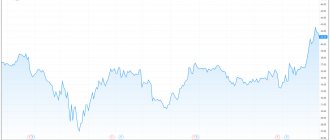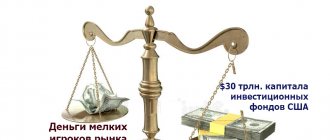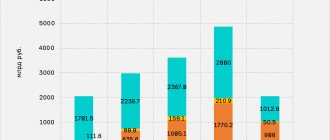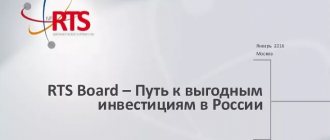In times of crisis in the economies of different countries, confidence in the future can be ensured by investing in less profitable, but also less “risky” European companies, for example, in Spanish enterprises offering their shares on the stock exchange. Securities trading, like other types of business, stimulates the progressive development of the country's economy. Read our article on how the Spanish stock market works.
Presentation of the Madrid Stock Exchange (Bolsa de Madrid) and its main features
- The Madrid Stock Exchange is in the second tier of the world's largest stock exchanges – exchanges with securities market capitalization from $500 billion to $1 trillion.
In the author's rating of the Masterforex-V Academy, BME is at the bottom of the global TOP-20 (as of April 1, 2019) with a capitalization of $770 billion. Speaking separately about the European market, Bolsa de Madrid is in 6th position.
First echelon (trillionaire club):
- New York Stock Exchange – $23.211 trillion;
NASDAQ: No. 2 exchange in the world – $11.218 trillion;
- Tokyo Stock Exchange – $5.608 trillion;
- Shanghai Stock Exchange SSE – $5.013 trillion;
- Hong Kong Stock Exchange HKE – $4.307 trillion;
- Euronext (Paris, Amsterdam, Brussels, Lisbon, Dublin) – $4.268 trillion;
- London Stock Exchange LSE – $3.965 trillion;
- Shenzhen Stock Exchange SZSE – $3.355 trillion;
- Toronto Stock Exchange – $2.216 trillion;
- Bombay Stock Exchange BSE – $2.179 trillion;
- National Stock Exchange of India – $2.156 trillion;
- Frankfurt Stock Exchange - $1.867 trillion;
- Swiss Stock Exchange - $1,603 billion;
- Korean Stock Exchange - $1,468 billion;
- OMX Group Nasdaq Nordic Exchange (Vilnius, Iceland, Copenhagen, Riga, Stockholm, Tallinn, Helsinki, Armenian stock exchanges) - $$1.432 trillion;
- Australian Stock Exchange ASX - $1.384 trillion;
- Taiwan TWSE - $1.041 trillion.
Second echelon:
- Johannesburg Stock Exchange (South Africa) - $950 billion;
- Sao Paulo Stock Exchange (Brazil) - $820 billion;
- Madrid Stock Exchange BME - $770 billion;
- Singapore Stock Exchange - $715 billion;
- Moscow Stock Exchange MOEX - $636 billion;
- Saudi Stock Exchange, Tadawul - $558 billion;
- Stock Exchange of Thailand (SET) - $535 billion.
Spain has a huge labor force for Europe . Its population of 46.5 million people is 5th in the European Union (as of 2021 after Germany, France, Great Britain, and Italy). At the same time, in terms of GDP per capita, Spain is only 13th - $40.2 thousand, inferior even to the small island state of Malta (1,600 times smaller (!) in territory and almost 100 times smaller in population).
The government is trying to improve the business environment by attracting investors . In the global ranking of competitive economies, the Global Competitiveness Index for 2021, Spain made a serious leap forward (+8) and entered the TOP 30 (26th place). The Madrid Stock Exchange has considerable potential for growth; you should take a closer look at it. Political risks include an independence movement in Catalonia, the country's richest region, which is currently discouraging long-term investment.
The Spanish stock market is at crisis lows.
What can the country hope for?
13 April 2012, 13:37 Share The stock market and the dynamics of Spanish government bonds have recently been under the close attention of investors. The IBEX index has only 9% left to reach the minimum levels of the crisis year 2009. Will the ECB help the country or will it have to repeat the fate of Greece?
Spain is now one of the most discussed countries in the Eurozone, since it is the one that can repeat the fate of Greece. Spain's private sector debt amounts to 227% of its GDP, and its unemployment rate is the highest in the EU at 23%.
Moreover, among people under 25 years of age this figure exceeds 50%.
Spain's unemployment chart The country's economy is forecast to shrink by 1.7% this year.
All this is very noticeably reflected in the main stock index IBEX, which recently reached lows since the crisis and could break the record of 6,702 points, which was reached in March 2009.
IBEX Monthly Chart Spain's position in the debt market is also causing concern: the 10-year bond yield has been rising alarmingly over the past month and has increased from 4.9% to 5.8% since the beginning of March, with the 6% mark being tested. Meanwhile, exceeding 5% already means that the country is facing a debt crisis.
Spanish 10-year bond chart Today it was reported that Spanish banks attracted a record 227 billion euros in ECB loans in March, which is 50% more than last month.
This suggests that, despite the LTRO program, banks need more and more money. Against this background, IBEX today is falling by 2.4%, shares of the largest banks are losing about 2% of their capitalization, and the yield on 10-year bonds continued to rise to 5.88%.
Rajoy against EU help Meanwhile, the position of the country's leadership is interesting: Prime Minister Mariano Rajoy said that Spain does not need EU help and called financial support “impossible.” It should be noted that when a similar situation developed in Greece, Portugal and Ireland, these countries turned to the European Union for help. Thus, it can be assumed that Rajoy is trying to convince investors that the Spanish economy is sound.
The Spanish government says it aims to reduce its budget deficit this year from 8.5% to 5.3% of GDP, despite a recession and massive unemployment. It turns out to be a vicious circle. “Rahoy’s decisions are the Achilles heel of Spain’s fiscal policy,” said Nicolas Spiro, managing director of Spiro Sovereign Strategy.
“The pressure that markets are putting on Spain and the euro area is forcing the government to take new steps towards fiscal consolidation.”
Authorities are forcing regions to cut costs and lay off workers, especially in the medical and education sectors, which make up half of all government employees. So what can Spain expect? Perhaps the country has hope in the ECB, which may soon resume the purchase of government bonds of peripheral EU countries.
Experts predict exactly this scenario, since the program for providing
Listing conditions of the Madrid Stock Exchange (Bolsa de Madrid)
To place securities on Bolsa de Madrid, you must go through the listing procedure - verification by exchange experts and the national financial regulator - CNMV (National Stock Market Commission). For investors, this is a clear signal - the issuer is quite reliable, with a proven financial history, its shares are liquid, the company can generate profits and has achieved a very high level of management.
Listing on Bolsa de Madrid means prestige and additional advertising (regular mention in the feeds of authoritative economic publications - The Wall Street Journal, Financial Times, Reuters, Bloomberg, etc.).
Basic conditions for listing on the Madrid Stock Exchange:
- at least 25% of shares are in free circulation (that is, available to traders and investors);
- the prospectus must be registered with the CNMV (Spanish financial regulator, National Securities Market Commission);
- regular disclosure of financial statements and notification of all information companies.
Listing on the Madrid Stock Exchange is not fast. The entire process can take up to 9 months.
The complete current list of listed companies can be found on the corresponding page of the official website: bolsamadrid.es/ing/aspx/Empresas/Empresas.aspx
How to make money on the stock market
We have all heard about global stock markets; on a superficial level, everyone understands what we are talking about.
You can purchase company shares for $1 per share, and sell each security for 10 conventional units.
This is the simplest description of how to make money in the stock market. But modern realities are much more complex.
Trading stocks, bonds and bills becomes a very risky undertaking, because there are real professionals in the market who are ready to invest significant funds. By simple manipulations, they artificially increase or decrease the value of assets, manipulate the market and adjust it to their own interests. Today we will talk about making money in the stock market.
We will evaluate the chances of beginners, the minimum investment amount possible to start, consider the features and tools of professionals, and also talk about popular trading systems and strategies. It’s worth starting the conversation with an understanding of what the stock market is.
It’s not difficult to find the official definition on the Internet, but it is overly difficult to understand, so let’s try to formulate it in our own words.
The stock market is a special market system within which the turnover (purchase and sale) of securities occurs. A logical question immediately arises: where did the first securities come from and why are they needed?
The essence is quite simple: companies need to attract additional investments for their existence and development.
Investors plan to make money on the subsequent sale of a block of shares or receive constant profits as dividends. The concept of “securities” is quite broad.
This term refers to one of the following stock market assets:
- Regular shares. Depending on the percentage of ownership of the company's shares, the shareholder receives the right to receive dividends or to participate in the life of the company through shareholder meetings. This is the most common type of securities. Preferred shares. “Prefs” - that’s what professional stock exchange players call them; they enable the shareholder to receive regular profits from dividends, but at the same time they limit the opportunities to participate in the meeting of shareholders. Bonds. The foreign exchange market also provides players with such an interesting type of securities as bonds. It can be compared to a promissory note, upon the expiration of which it can be exchanged for money with interest.
It is a mistake to say that modern centralized stock exchanges provide the opportunity to trade bills. They are only transferred from creditor to debtor.
Experienced economists may think of options or futures, but they are also sold in a special type of market - derivatives markets that are not related to the stock market. A few words should be said about participants in the securities market. They can be divided into 4 large categories: Issuers. This role is taken on by companies that issue shares and put them up for sale on the stock exchange.
The very first issue is called an IPO.
It is through this that the enterprise receives its first investments and the opportunity to develop its business. Investors.
List of securities on the Madrid Stock Exchange (Bolsa de Madrid)
Traders and investors have the opportunity to earn money on the Madrid Stock Exchange on the following securities trading instruments (as of 06/16/2019):
- shares (165);
- ETF funds (5);
- warrants (5);
- certificates;
- stock (exchange) indices;
- futures and options;
- fixed interest instruments.
Exchange device
The latest information system of the exchange was created taking into account the requirements of traders. The bidding process is displayed on the main large LCD monitor, which is located in the very center of the trading floor. This became possible thanks to an order placed by the exchange administration for the supply of equipment from one of the largest companies on the exchange, Telefonica. Today, 52-inch Mitsubishi MDT 521s LCD monitors, which are controlled by DISE software, are hung around the perimeter of the hall. With the help of modern software, all content is controlled remotely, from one point, and besides, the program is able to adapt to any monitor characteristics.
IBEX 35 - blue chip index of the Madrid Stock Exchange (Bolsa de Madrid)
On any exchange there are companies with very high capitalization compared to others. They are called "blue chips". So that traders interested in buying shares of only the most expensive companies do not have to spend a long time searching, there are blue chip indices, the basket of which selects the securities of the largest issuers listed on the stock exchange.
The blue chip index of the Madrid Stock Exchange is the IBEX 35 . Its basket contains 35 shares of companies with capitalizations ranging from 77.9 billion euros (INDITEX) to 0.9 billion euros (ENCE).
IBEX 35 Index Structure:
- 7 energy sector companies;
- 6 financial sector companies;
- 2 each - telecommunications, tourism, real estate, steel production, pulp production, multifunctional corporation;
- 1 each - clothing production/sale, airport operator, airline, investment, pharmaceuticals, automotive industry, construction, advertising, insurance, consulting.
13 blue chips of the Madrid Stock Exchange (capitalization as of June 14, 2019):
- INDITEX $87.3 billion. Chain of clothing stores. Brands Zara, Oysho, Massimo Dutti, Bershka, etc.
- BA.SANTANDER $71.94. A large bank with assets of about EUR1.5 trillion.
- IBERDROLA $65.44. Production and supply of electricity, supply of natural gas.
- TELEFONICA $43.26. A telecommunications company with a subscriber base of 325 million. It provides mobile communication services under the brands O2, Movistar, VIVO.
- BBVA (Banco Bilbao Vizcaya Argentaria) $36.42. Large bank. Number 1 in the Mexican financial market, number 2 in Spain, Turkey and Peru.
- AMADEUS $33.39. Global distribution system, tourism. Among the founders are Air France and Lufthansa.
- AENA $29.02. Airport operator. Provides air traffic control services, provides information that ensures its safety (communications, navigation, etc.).
- NATURGY $28.46. Electricity production, natural gas distribution.
- ENDESA $28.13. An energy company that owns nuclear power plants, thermal power plants, and hydroelectric power plants.
- REPSOL $24.88. Extraction, processing and distribution of oil and gas.
- FERROVIAL $18.38. Design, construction and management of infrastructure facilities.
- CAIXABANK $17.26. A bank with assets of about $0.5 trillion.
- ARCELORMITTAL $16.70. A large metallurgical company with enterprises around the world.
Evolution of the Spanish banking system
Banking in Europe appeared a long time ago. But the Spanish banking system did not grow out of the banking houses of the Middle Ages, but appeared at the end of the 18th century by royal decree.
In 1792, the Banco Nacional de San Carlos, the Central Bank of Spain, was founded. It was led by the French banker Francisco Cabarrus.
During the Napoleonic wars, the Bank's affairs were upset, it received government support. And this support caused financial problems for the Spanish government itself.
In 1829, the Bank changed its name to Banco Espanol de San Fernando. In 1847, it was joined by another large bank, opened three years earlier - Banco de Isabel II.
In 1844, Banco de Barcelona also appeared, and in 1846, Banco Español de Cádiz. In 1857 - Banco de Bilbao. These were already commercial banks that served the interests of the growing bourgeoisie, industry and commercial enterprises.
In 1876, Banco Hispano Colonial appeared, but with the loss of the colonies it fell into decline and was revived in 1901 under the new name Banco Hispano Americano.
In the 20th century, many more banks appeared, universal or specializing in a certain industry, for example, fishing. Small businesses and agricultural producers are increasingly turning to banks.
Until the beginning of the 90s, i.e. Before the European integration of Spain, the banking sector developed in parallel with the national economy and the demand for banking services, i.e. on the Middle level.
Everything changed in 1994, thanks to European integration, commercial banks in Spain received better access to foreign resources. The volume of credit transactions has increased. Loans revived business, housing construction and other areas. The role of the Spanish financial sector has increased.
Stock indices of the Madrid Stock Exchange (Bolsa de Madrid)
The Madrid Stock Exchange has a huge number of indices, the baskets of which include shares of large or small companies, divided by economic sectors, etc.
The main stock indices of the Madrid Exchange are:
- IGBM (a basket of 113 shares, the index reflects income or loss due to an increase or decrease in the value of shares);
- IBEX 35 (blue chip index - shares of the 35 largest companies listed on the stock exchange).
Some indices are compiled in partnership with the reputable FTSE, for example:
- FTSE 4Good IBEX;
- FTSE Latibex All Share;
- FTSE Latibex BRASIL.
Other indices of the Madrid Stock Exchange:
- IBEX MEDIUM CAP (mid-capitalization market);
- IBEX SMALL CAP (small capitalization market);
- IBEX 35 Bancos (banking sector);
- IBEX 35 Energia (energy sector);
- other.
The largest companies on the stock exchange
| Company | Description | $, billion |
| Telefonica SA | multinational Spanish telecommunications company | 71, 8 |
| Inditex | produces and markets textiles | 33,3 |
| Abertis | manages highways and telecommunications infrastructure | 17,68 |
| ACS | construction and provision of various services | 12,4 |
| Abengoa | energy and environmental protection | 2,71 |
IGBM is the second index of the Madrid Stock Exchange (Bolsa de Madrid)
The second main index of the Madrid Stock Exchange is IGBM. It was first calculated in 1940. On December 31, 1985, a transformation took place, the index received a base value of 100 and is calculated as a continuous historical series.
The peculiarity of the IGBM index is that it reflects only income or loss generated as a result of a rise or fall in quotes.
There are 113 stocks in the IGBM index basket.
ETFs and warrants on the Madrid Stock Exchange (Bolsa de Madrid)
The Madrid Stock Exchange does not have a large number of ETF offerings. There are less than a dozen of them:
- ACCION IBEX 35 ETF, FI COTIZ, ARM (copies the IBEX 35 blue chip index);
- LYXOR IBEX 35 DOB INV.DIAR UCITS ETF ACC (copies the IBEX 35 DOBLE INVERSO index);
- LYXOR IBEX 35 (DR) UCITS ETF ACC (copies the IBEX 35 NET TOTAL RETURN index);
- LYXOR IBEX 35 DOB.APAL.DIA UCITS ETF ACC (copies the IBEX 35 DOBLE APALANCADO NETO index).
Warrants on the Madrid Stock Exchange:
- CALL WARRANTS B.SANTANDER 3.50 BNP PARIBAS ARBITRAGE ISSUANCE
- CALL WARRANTS IBEX35 9000.00 BNP PARIBAS ARBITRAGE ISSUANCE
- PUT WARRANTS IBEX35 9500.00 BNP PARIBAS ARBITRAGE ISSUANCE
- PUT WARRANTS ACX 10.00 SG ISSUER
- CALL WARRANTS BBVA 4.50 COMMERZBANK AG
Alternative markets of the Madrid Stock Exchange (Bolsa de Madrid)
- Latibex – market for companies from Latin America. The market provided investors from Europe with the opportunity to centrally buy shares of the Latin American stock market for euros, according to clear, uniform rules.
Latibex market ETF:
- FTSE Latibex All Share - all companies listed on Latibex.
FTSE Latibex Top - the most liquid securities on Latibex.
- FTSE Latibex Brasil is the most liquid Brazilian securities on Latibex.
- The MaB market is a market for small companies that want to attract investment by issuing shares, but have not yet matured to the criteria of the main market. Special, easier rules for admission to trading have been developed for this segment.
The number of securities on the market is 24.
Solution
After replacing the headquarters equipment with servers running Intellect software, the two systems were combined into a single global video surveillance system. This association solved several important problems, such as:
- unification of security service workplaces;
- the possibility of enhanced visual control of particularly important areas;
- increased controllability and expandability of the system;
- increasing the efficiency of maintenance.
At the moment, the system includes about 160 cameras processed by 4 servers, and 4 remote workstations operating in multi-monitor mode. Cross-observation is carried out at certain hours. The following solutions were implemented specifically within the framework of this task:
- a control panel for audio alarms has been developed individually for each camera;
- The script for working with the operator monitor has been improved. The operator can “pull” cameras of interest to him from the main surveillance monitors onto his desktop.
Internal programming capabilities made it possible to adapt Intellect to the maximum for more efficient and controlled operator work.
“...I would like to highlight the exceptional support of ITV in this project. Both AFELSA and the client could always count on the unconditional support of ITV’s technical specialists, who demonstrated outstanding professional and personal abilities,” Fernando López Suárez, Technical Director of AFELSA
Masterforex-V recommendations for trading the IBEX 35 index
- For investors. IBEX 35 is one of the outsiders among the world's leading stock indices , for which we DO NOT recommend opening buy transactions for LONG-TERM (approximately ten-year) investment according to the supposed Bullish impulse, as for the American indices Dow Jones 30 and S&P 500, Canadian S&P/TSX 60, British FTSE 100, because they are in 2009-2019. managed to update their historical highs of 2008. and gain a foothold ABOVE them. As can be seen in the chart, the IBEX 35 index failed to break through the historical maximum of 2007.
- For traders. IBEX 35 is quite an interesting and volatile financial instrument for trading, if... you know the current strong and minor levels of order accumulation from the Masterforex-V Academy, some of which are shown in the following chart.
Professional traders of Masterforex-v work on different, and not on ONE market (Madrid, Moscow, Swiss or New York exchange). What is important to a successful trader is not a specific market (stock, cryptocurrency, commodity, foreign exchange), but the trend, which varies by instrument in different months. So, in the current month the trend may be in EUR CHF, USD SEK or NZD USD, AUD USD, in the next - in shares and stock market indices, in the third - in BTC and cryptocurrencies, the fourth - in futures and CFDs of oil or wheat, etc. d. and so on.
It is by working in DIFFERENT markets that you can earn 300%-700% in a few years , like Masterforex-V traders according to the statistics of our Rebate - autocopying service pro-rebate.com. No bond, share, index, ETF or ETP fund can provide such returns for investors over any period in the history of their trading.
Situation
An exchange is a complex financial structure that includes many divisions. The importance of such facilities requires special requirements for the video surveillance system, the modernization of which began in 2010. Then the MSE security department decided to switch from obsolete equipment, which could not adequately solve the problems of effective security control and optimization of the work of exchange employees, to a modern security system.
As a result of testing several systems, the integrated Intellect complex from the security and video surveillance software developer ITV was chosen as the software platform.
“Why did you choose “Intelligence”? When we were introduced to Intellect, we saw that this application was very easy to manage. We drew attention to the large amount of integrated equipment, the ability to share network and analog cameras, as well as integration with security and access control systems, and ITV’s desire to expand this list. We appreciate the possibility of free updates, which allows us to keep up with progress and, if necessary, use almost any modern IP equipment. A very important feature for us is the distributed architecture, which makes it possible to combine all of our divisions and offices into a single global system with remote control. What has improved since you started using Intellect software? First of all, I would like to note the ease of working with the system.
Another point that I would like to highlight is the convenience and flexibility of configuration, which allows you to quickly adapt the product to current tasks, which is often impossible or very difficult with other products. Technical support for the product is beyond praise; they help us solve all our tasks. In conclusion, I want to say that we are satisfied with Intellect, and when the question arose about replacing a system in one of our offices, we chose this software again,” Emilio Dólera Crespo, responsible for technical support of the BME Security Department
The security system expansion project was implemented by AFELSA. At the first stage of work, analog cameras were connected through Axis encoders, which made it possible to implement full control both inside the building and its perimeter.
“Axis offers a wide range of hybrid solutions that help our customers integrate their existing analog solutions into IP systems. This protects the initial investment in analog video, enables integration with other security systems and removes any scaling limitations with software such as Axxon Intellect Enterprise,” Mario Gutierrez, Communications Manager, Axis Communication Iberia Press Center
In 2013, after three years of operation of the system, it became necessary to globalize the BME video surveillance system between the exchange building and the operational headquarters in the Las Rozas area, located approximately 30 kilometers from each other.
Choosing a broker for trading stock indices
The widest selection of financial instruments for working on DIFFERENT markets is presented by the English forex broker FxPro , which is one of the recommended brokers of our Rebate - autocopy service pro-rebate.com and the TOP rating of brokers of the Masterforex-V Academy.
The FxPro.com trading terminal contains:
- 141 “blue chip” shares - shares of companies in the USA, Great Britain, Germany, France, etc.;
- more than 70 forex currency pairs, including EUR USD, GBP USD, USD JPY, USD CHF, USD CAD, NZD USD, AUD USD, USD RUB, EUR RUB, USD SEK, USD NOK, etc.;
- 24 stock (exchange) indices, incl. South African FTSE/JSE Top 40 (JTOPI) - #South Africa40, Australian S&P/ASX 200 (#AUS200), Taiwanese TAIEX, Canadian S&P/TSX 60 (#Canada60), Japanese NIKKEI 225 (Japan225), Euro Stoxx 50 (#Euro50 ), American Dow Jones 30, NASDAQ-100, and S&P 500, Hong Kong Hang Seng 50 (#HongKong50), BSE SENSEX 30 (India), German DAX 30 (#Germany30), IBEX 35 (#Spain35), Swiss SMI 20. British FTSE 100 (#UK100), Chinese SSE 50,
The broker provides
- a trading platform familiar to all traders for Meta Trader 4 and Meta Trader 4 Mobile traders with the largest group of built-in indicators and oscillators for technical analysis of charts;
- minimum trading account from $100 (note: the minimum recommended deposit for money management MF is from $800-$1000 when trading 0.01 0 lot)
- leverage from 1:30 to 1:500;
- All types of trading strategies are allowed, from automated advisors to day trading, swing trading, scalping, etc.
The broker's trading accounts are insured up to 20,000 euros from the Investor Compensation Fund in case of bankruptcy of the company (compensation for non-trading risks).
When opening a real trading account from $3000 with FxPro, a trader receives the opportunity to study for free for 1 year at the Masterforex-V Academy.










